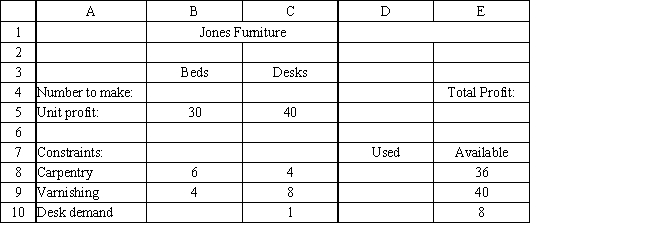Exhibit 3.1
The following questions are based on this problem and accompanying Excel windows.
Jones Furniture Company produces beds and desks for college students. The production process requires carpentry and varnishing. Each bed requires 6 hours of carpentry and 4 hour of varnishing. Each desk requires 4 hours of carpentry and 8 hours of varnishing. There are 36 hours of carpentry time and 40 hours of varnishing time available. Beds generate $30 of profit and desks generate $40 of profit. Demand for desks is limited, so at most 8 will be produced.  The LP model for the problem is
The LP model for the problem is 

-Refer to Exhibit 3.1. Which of the following statements represent the carpentry, varnishing and limited demand for desks constraints?
Definitions:
Research Hypotheses
Statements made by researchers that propose a potential relationship between two or more variables.
Research Hypothesis
A specific, testable prediction about what you expect to happen in your study, often based on a theory or prior research.
Modality
The method or mode in which something exists or is experienced or expressed.
Interval Scale
A numerical scale where the order of values and the exact differences between them are known, but there is no true zero point.
Q17: If results testing produces unsatisfactory results<br>A) the
Q31: Refer to Exhibit 7.3. Which value should
Q40: The concept of "probortunity" is<br>A) the first
Q53: Refer to Exhibit 8.1. What formula is
Q59: The following diagram shows the constraints for
Q66: The individual's limited income problem:<br>A) persists only
Q73: The simplex method of linear programming (LP):<br>A)
Q80: When the lines connecting the nodes in
Q83: Scaling problems<br>A) can cause Analytic Solver Platform
Q184: Other things equal, which of the following